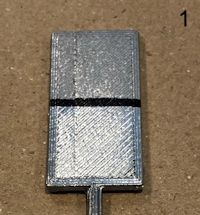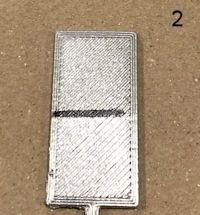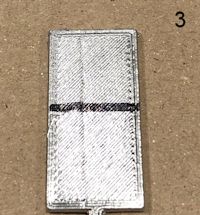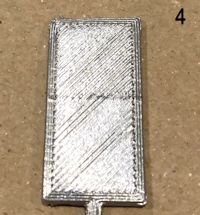JonW
Active Member
- Joined
- Feb 20, 2021
- Messages
- 63
I've been making 1:18 light bars and other police car parts with my 3D printer. I needed a way to paint them with chrome paint. The problem is that with most chrome paint, you cannot touch the part after painting or it could turn dull where it's touched. The other issue is that trying to protect the chrome painted part with a clear coat can also cause discoloration or dulling issues. So I decided to do some experimenting. I do not have an airbrush, so whatever products I chose had to be in a rattle can. There is also Molotow chrome in pen form, and I will discuss that at the end of this review.
For this test, I chose 4 "chrome" paints in rattle cans. I painted a 3D printed test stick with each paint, 4 test sticks in all. After letting the test stick dry for 48 hours, I covered the top half of the paint sticks with a top coat. I let that dry for 48 hours. I photographed the paint sticks with half coated and half uncoated so you could hopefully see the difference. Then I touched the uncoated part 10 times, as if I were picking it up to place on a model. This was touch and release, not holding for an extended period. The last test was the rub text, where I forcefully rubbed my thumb over the uncoated part to see if any paint rubbed off.
Here are the results:
Test #1: ACE Hardware Chrome Paint with Krylon Crystal Clear top coat

The Krylon clear coat definitely changed the color of the paint.
Touch test: pass
Rub test: fail
Test #2: Duplicolor Chrome Paint with Krylon Crystal Clear top coat

The Krylon clear coat definitely changed the color, but not as much as test #1
Touch test: pass
Rub test: fail
Test #3: Eastwood Almost Chrome paint with Krylon Crystal Clear top coat

The Eastwood paint is marketed as a paint to restore the inside of tail light housings. At first, it appeared that the Krylon clear coat discolored the paint stick as much as tests #1 and #2, but once the Krylon dried, it was less obvious.
Touch test: pass
Rub test: Some paint rubbed off, but not nearly as much as tests #1 and #2
Test #4: ACE Hardware Chrome paint with Eastwood Almost Chrome top coat

From an appearance stand point, this was the best result.
Touch test: pass
Rub test: fail
For test #4, I thought the use of the Eastwood paint as a top coat would yield better results, but it did not. It fared worse than the Krylon as a protective top coat.
The ACE Hardware and Eastwood Almost Chrome look the most like chrome, at least as much as possible from a rattle can. The Duplicolor looked like shiny silver. The difference I noticed between the ACE and Eastwood paints is that the Eastwood seemed a bit more splotchy. I found that all the paints seemed to leech into the 3D printed parts and highlighted the layer lines more. As a result, I now spray my parts with a coat of Krylon Crystal Clear before spraying the chrome. The Krylon seems to level out the layer lines a bit, plus it gives me the opportunity to do some more sanding if necessary.
For my use, I will be using the ACE Hardware chrome paint. It is very reflective and looks the most like real chrome. I've found that if I let it cure for at least 48 hours, I can pick the part up and place it on the model with no ill effects. I've 3D printed some tools to use to hold the part in place until the glue sets. I've also found that if I spray the ACE paint a little dry, it looks more like stainless steel than chrome.
I've also experimented with the Molotow chrome pen. It definitely looks like real chrome. I use it for parts that are difficult to sand. I can apply the Molotow thick, so it flows out and helps hide the layer lines. I can also apply two coats if necessary, waiting 48 hours between coats. The Krylon Crystal Clear failed miserably on the Molotow, turning it a battleship gray. However, the Eastwood Almost Chrome only dulls it slightly, and at least makes it where the part can be handled sparingly. With no top coat, the Mototow chrome dulls as soon as you touch it.
Let me know if you have any questions.
For this test, I chose 4 "chrome" paints in rattle cans. I painted a 3D printed test stick with each paint, 4 test sticks in all. After letting the test stick dry for 48 hours, I covered the top half of the paint sticks with a top coat. I let that dry for 48 hours. I photographed the paint sticks with half coated and half uncoated so you could hopefully see the difference. Then I touched the uncoated part 10 times, as if I were picking it up to place on a model. This was touch and release, not holding for an extended period. The last test was the rub text, where I forcefully rubbed my thumb over the uncoated part to see if any paint rubbed off.
Here are the results:
Test #1: ACE Hardware Chrome Paint with Krylon Crystal Clear top coat

The Krylon clear coat definitely changed the color of the paint.
Touch test: pass
Rub test: fail
Test #2: Duplicolor Chrome Paint with Krylon Crystal Clear top coat

The Krylon clear coat definitely changed the color, but not as much as test #1
Touch test: pass
Rub test: fail
Test #3: Eastwood Almost Chrome paint with Krylon Crystal Clear top coat

The Eastwood paint is marketed as a paint to restore the inside of tail light housings. At first, it appeared that the Krylon clear coat discolored the paint stick as much as tests #1 and #2, but once the Krylon dried, it was less obvious.
Touch test: pass
Rub test: Some paint rubbed off, but not nearly as much as tests #1 and #2
Test #4: ACE Hardware Chrome paint with Eastwood Almost Chrome top coat

From an appearance stand point, this was the best result.
Touch test: pass
Rub test: fail
For test #4, I thought the use of the Eastwood paint as a top coat would yield better results, but it did not. It fared worse than the Krylon as a protective top coat.
The ACE Hardware and Eastwood Almost Chrome look the most like chrome, at least as much as possible from a rattle can. The Duplicolor looked like shiny silver. The difference I noticed between the ACE and Eastwood paints is that the Eastwood seemed a bit more splotchy. I found that all the paints seemed to leech into the 3D printed parts and highlighted the layer lines more. As a result, I now spray my parts with a coat of Krylon Crystal Clear before spraying the chrome. The Krylon seems to level out the layer lines a bit, plus it gives me the opportunity to do some more sanding if necessary.
For my use, I will be using the ACE Hardware chrome paint. It is very reflective and looks the most like real chrome. I've found that if I let it cure for at least 48 hours, I can pick the part up and place it on the model with no ill effects. I've 3D printed some tools to use to hold the part in place until the glue sets. I've also found that if I spray the ACE paint a little dry, it looks more like stainless steel than chrome.
I've also experimented with the Molotow chrome pen. It definitely looks like real chrome. I use it for parts that are difficult to sand. I can apply the Molotow thick, so it flows out and helps hide the layer lines. I can also apply two coats if necessary, waiting 48 hours between coats. The Krylon Crystal Clear failed miserably on the Molotow, turning it a battleship gray. However, the Eastwood Almost Chrome only dulls it slightly, and at least makes it where the part can be handled sparingly. With no top coat, the Mototow chrome dulls as soon as you touch it.
Let me know if you have any questions.

